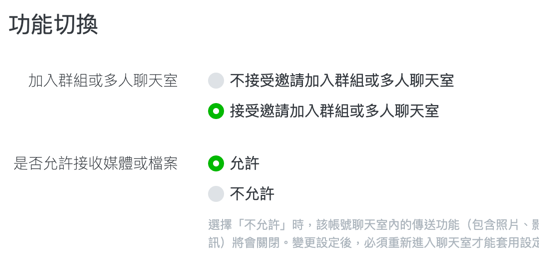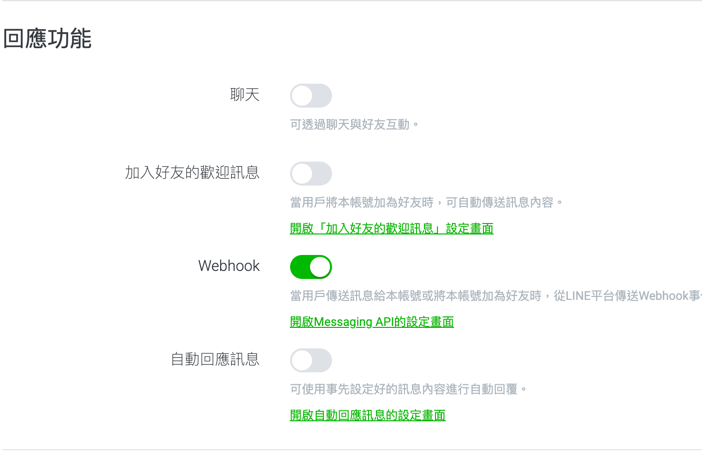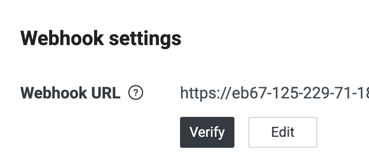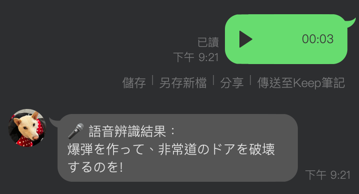Line Bot Message API with Audio x OpenAI Whisper
這邊主要記錄如何透過 Line Bot Message API 來接收音訊檔案, 並藉由 OpenAI 的 Whisper 來處理音訊檔案, 最終回傳轉換後的文字訊息
建立 Line Bot
-
先到 Line Developers 建立一個 Provider
-
在 Provider 中建立一個 Messaging API Channel, 這邊會要求建立對應的 LINE Official Account (前面沒有建立 Provider 的話也可以這邊建立, 或者選擇已有的, 然後認證帳號的部分可以先跳過不影響)
-
建立後可以先點右上方的設定調整一些需求, 例如帳號設定中的功能切換可以決定是否接受邀請至群組及聊天室, 以及回應設定中的回應功能也可以自行調整 (Webhook 的部分需要等我們設定 Webhook URL 後才能開啟)


-
設定好後在 Line Developers 的 Messaging API Channel 中可以取得 Channel Access Token
-
記得將 Bot 加入到對應的群組或聊天室中, 這樣待會才能接收訊息
在專案上建立對應的 Line Utility
安裝相關套件
pnpm add @line/bot-sdk --filter=YOUR_APPS
先設定對應的 config, constants
export const lineConfigFactory = registerAs('line', () => {
return {
botChannelAccessToken: process.env.LINE_BOT_CHANNEL_ACCESS_TOKEN
};
});
LINE_BOT_CHANNEL_ACCESS_TOKEN 是剛剛在 Line Developers Message API 中取得的 Channel Access Token, 記得設定在 .env 中
export function loadConfigImports() {
// ...
return [
ConfigModule.forRoot({
envFilePath: ['.env', '.env.development', '.env.staging', '.env.production'],
isGlobal: true,
load: [
// ...
lineConfigFactory
],
expandVariables: true // Enable environment variable expansion
})
// ...
];
}
const lineBotExceptions = {
PARSE_AUDIO_FAILED: {
code: 'PARSE_AUDIO_FAILED',
message: 'Failed to parse audio',
origin: 'main',
statusCode: 500
}
// ...
};
export default lineBotExceptions;
建立 Line Bot Utility
import * as querystring from 'node:querystring';
import { Readable } from 'node:stream';
import { EventSource, messagingApi, WebhookEvent } from '@line/bot-sdk';
import { Injectable } from '@nestjs/common';
import { ConfigService } from '@nestjs/config';
// ...
const { MessagingApiClient } = messagingApi;
@Injectable()
export class LineBotUtility {
private channelAccessToken: string;
private lineClient: messagingApi.MessagingApiClient;
constructor(private configService: ConfigService) {
this.channelAccessToken = this.configService.get<string>('line.botChannelAccessToken');
this.lineClient = new MessagingApiClient({
channelAccessToken: this.channelAccessToken
});
}
public async handleLineEvents(events: WebhookEvent[]): Promise<any[]> {
return Promise.all(
events.map(async (event: WebhookEvent) => {
const source: EventSource = event.source;
this.logger.debug(`receive line event: ${JSON.stringify(event)}`);
this.logger.debug(`event source: ${JSON.stringify(source)}`);
switch (event.type) {
// ...
case 'message': {
// 這邊可以處理從 Line 傳進來的訊息
const message = event.message;
if (message.type === 'text') {
const userText = message.text;
await this.lineClient.replyMessage({
replyToken,
messages: [
{
type: 'text',
text: `你說了:${userText}`
}
]
});
}
return;
}
default:
return;
}
})
);
}
}
上面在 message type 為 text 的時候先回覆傳入的文字訊息, 這時候我們可以先建立 Service, Controller, Module 來測試
建立 Service, Controller, Module
// ...
@Injectable()
export class LineBotService {
constructor(private lineBotUtility: LineBotUtility) {}
async handleLineBotWebhook(events: WebhookEvent[]) {
return this.lineBotUtility.handleLineEvents(events);
}
}
// ...
@Controller('line-bot')
export class LineBotController {
constructor(private readonly lineBotService: LineBotService) {}
@Post('webhook')
async handleLineBotWebhook(@Body() _body: { destination: string; events: WebhookEvent[] }) {
const { events } = _body;
return this.lineBotService.handleLineBotWebhook(events);
}
}
// ...
@Module({
imports: [],
controllers: [LineBotController],
providers: [LineBotService, LineBotUtility]
})
export class LineBotModule {}
然後將 LineBotModule import 至 App Module 中
建立 Webhook URL
我們可以使用 ngrok 來建立一個可以讓外部存取的 URL, 方便我們在開發的時候可以讓 Line Bot 送訊息過來做測試
ngrok http NUMBER // NUMBER 為你的 server port
然後將這個 URL 設定到 Line Developers 的 Messaging API Channel 中的 Webhook URL (url 後面的 endpoint 記得要設定到對應的 controller)

驗證成功後就可以傳送一般訊息來測試

串接 OpenAI Whisper
- 先至 OpenAI 註冊帳號, 並且建立一把 API Key
安裝相關套件
pnpm add openai --filter=YOUR_APPS
先設定對應的 config, constants
export const aiConfigFactory = registerAs('ai', () => {
return {
openaiApiKey: process.env.OPENAI_API_KEY
};
});
OPENAI_API_KEY 是剛剛在 OpenAI 中建立的 API Key, 記得設定在 .env 中
export function loadConfigImports() {
// ...
return [
ConfigModule.forRoot({
envFilePath: ['.env', '.env.development', '.env.staging', '.env.production'],
isGlobal: true,
load: [
// ...
aiConfigFactory
],
expandVariables: true // Enable environment variable expansion
})
// ...
];
}
const openaiExceptions = {
WHISPER_TRANSCRIPTION_FAILED: {
code: 'WHISPER_TRANSCRIPTION_FAILED',
message: 'Whisper failed to transcribe audio',
origin: 'main',
statusCode: 500
}
};
export default openaiExceptions;
建立 OpenAI Utility 並透過 whisper-1 model 來處理 Audio
import fs from 'node:fs';
import * as path from 'node:path';
import { Injectable } from '@nestjs/common';
import { ConfigService } from '@nestjs/config';
import { OpenAI } from 'openai';
// ...
@Injectable()
export class OpenaiUtility {
private openai: OpenAI;
constructor(
private configService: ConfigService,
private exceptionUtility: ExceptionUtility
) {
const openaiApiKey = this.configService.get<string>('openaiApiKey');
this.openai = new OpenAI({
apiKey: openaiApiKey
});
}
/**
* Transcribe audio using OpenAI's Whisper model
*/
public async transcribeAudioViaFile(audioBuffer: Buffer): Promise<string> {
try {
const tmpFile = path.join(process.cwd(), 'temp_audio.m4a');
fs.writeFileSync(tmpFile, audioBuffer);
const transcription = await this.openai.audio.transcriptions.create({
file: fs.createReadStream(tmpFile),
model: 'whisper-1'
});
fs.unlinkSync(tmpFile);
return transcription.text;
} catch (error: unknown) {
this.exceptionUtility.handleCatchErrorHelper({
error,
logMessage: '[transcribeAudioViaFile] failed',
customError: { ...openaiExceptions.WHISPER_TRANSCRIPTION_FAILED },
enableThrow: true
});
}
}
}
調整 Line Bot Utility 並接上 Openai
原本 Line bot 提供的 Client 已經被設定為棄用
/**
* @deprecated Use clients generated by openapi spec instead.
*/
export default class Client {}
所以這邊已經改為使用 messagingApi.MessagingApiClient 來處理, 但 MessagingApiClient 並沒有提供原本的 getMessageContent 方法, 所以這邊另外實作 getMessageContent 方法
import { Injectable } from '@nestjs/common';
import { Readable } from 'stream';
import { HttpRequestUtility } from '@/core/utils/http-request.utility';
@Injectable()
export class ExtendedMessagingApiClientUtility {
private readonly dataApiPrefix = 'https://api-data.line.me/v2/bot';
constructor(private readonly httpRequestUtility: HttpRequestUtility) {}
public async getMessageContent(messageId: string, channelAccessToken: string): Promise<Readable> {
const url = `${this.dataApiPrefix}/message/${messageId}/content`;
const readStream: Readable = await this.httpRequestUtility.sendRequest({
url,
method: 'GET',
responseType: 'stream',
options: {
headers: {
Authorization: `Bearer ${channelAccessToken}`
}
}
});
return readStream;
}
}
httpRequestUtility 是搭配 @nestjs/axios 來處理 http request 的 utility (可以改成其他 fetch 方式)
import { HttpService } from '@nestjs/axios';
import { Injectable } from '@nestjs/common';
import { AxiosError, AxiosRequestConfig, Method } from 'axios';
import { Request as ExpressRequest } from 'express';
import { catchError, firstValueFrom } from 'rxjs';
//...
@Injectable()
export class HttpRequestUtility {
constructor(private readonly httpService: HttpService) {}
public async sendRequest({
url,
method,
options = {
headers: {
'Content-Type': 'application/json'
}
},
responseType = 'json'
}: {
url: string;
method: Method;
options?: {
data?: any;
headers?: Record<string, string>;
req?: ExpressRequest;
cancelable?: boolean;
};
responseType?: AxiosRequestConfig['responseType'];
}): Promise<any> {
const config: AxiosRequestConfig = {
method,
url,
responseType,
headers: {
...options.headers
},
validateStatus: status => status >= 200 && status < 300
};
if (options?.data) {
config.data = options.data;
}
if (options?.req && options.cancelable) {
const controller = new AbortController();
options.req.on('close', () => {
controller.abort();
});
config.signal = controller.signal;
}
const response = await firstValueFrom(
this.httpService.request(config).pipe(
catchError((error: AxiosError) => {
throw error;
})
)
);
if (!response || response?.data === null || response?.data === undefined) {
throw throwValidationError(serverException.INTERNAL_SERVER_ERROR);
}
return response.data;
}
}
然後在 LineBotUtility 中使用這個方法來取得音訊檔案
// ...
switch (message.type) {
case 'audio':
try {
const contentStream: Readable = await this.extendedMessagingApiClientUtility.getMessageContent(message.id, this.channelAccessToken);
const chunks: Buffer[] = [];
for await (const chunk of contentStream as AsyncIterable<Buffer>) {
chunks.push(chunk);
}
const audioBuffer = Buffer.concat(chunks);
// call OpenAI Whisper to transcribe audio
const textResult = await this.openaiUtility.transcribeAudioViaFile(audioBuffer);
await this.lineClient.replyMessage({
replyToken,
messages: [
{
type: 'text',
text: `🎤 語音辨識結果:\n${textResult}`
}
]
});
} catch (error: unknown) {
await this.lineClient.replyMessage({
replyToken,
messages: [
{
type: 'text',
text: '語音辨識失敗,請稍後再試或確認檔案格式是否正確。'
}
]
});
this.exceptionUtility.handleCatchErrorHelper({
error,
logMessage: '[handleLineEvents] parsed audio failed',
customError: { ...lineBotExceptions.PARSE_AUDIO_FAILED },
enableThrow: true
});
}
break;
// ...
default:
break;
}
// ...
這樣就可以透過 Line Bot 來串接 OpenAI 的 Whisper 來處理音訊檔案了

轉換完的文字也可以再去做其他處理